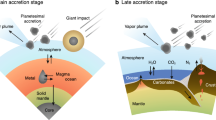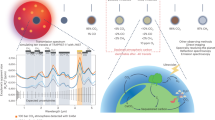Abstract
The most recent analyses of infrared spectrophotometric studies of Neptune's satellite Triton concluded that both condensed methane and nitrogen are present1,2. It was also concluded2 that the most likely surface configuration is a liquid nitrogen (N2) ‘ocean’ with dry areas of solid methane (CH4), and perhaps some exposed fine-grained water frost (H2O). However, this model runs into some difficulties, especially when requirements of phase equilibrium between the solid and liquid components are imposed. Because an understanding of the distribution and state of volatiles is crucial in interpreting secular changes in Triton's appearance due to seasonal effects3, and in planning observing strategies for the Voyager–Neptune/Triton encounter, we assess here several possible configurations for these volatiles on Triton. We conclude that the simplest volatile configuration which best satisfies the constraints with the least number of ad hoc assumptions is N2 and CH4 both in solid forms, perhaps partly as a microscopic mixture, but more probably as a disequilibrium assemblage, non-uniformly distributed. Thermodynamic equilibrium is then limited by seasonal transport and the finite diffusion time of CH4 in crystalline N2. Although a nitrogen ocean cannot be excluded, it requires very restrictive assumptions.
This is a preview of subscription content, access via your institution
Access options
Subscribe to this journal
Receive 51 print issues and online access
$199.00 per year
only $3.90 per issue
Buy this article
- Purchase on Springer Link
- Instant access to full article PDF
Prices may be subject to local taxes which are calculated during checkout
Similar content being viewed by others
References
Cruikshank, D. P. & Apt, J. Icarus 58, 306–311 (1984).
Cruikshank, D. P., Brown, R. H. & Clark, R. N. Icarus 58, 293–305 (1984).
Trafton, L. Icarus 58, 312–324 (1984).
Rieke, G. H., Lebofsky, M. J. & Lebofsky, L. A. Nature (in the press).
Moran, D. W. thesis, Imperial College, London (1959).
Omar, M. H., Dokoupil, Z. & Schroten, H. G. M. Physica 28, 309–329 (1962); Connolley, D., Milbrodt, T. & Stoner, R. J. J. chem. Phys. 73, 5388–5390 (1980).
Lunine, J. I. thesis, California Institute of Technology, Pasadena (1985).
Jones, M. C. Far Infrared Absorption in Liquified Gases (NBS Techn. Note 390, Washington DC, 1970).
Patel, C. K. N., Nelson, E. T. & Kerl, R. J. Nature 286, 368–370 (1980).
Ewing, G. E. J. chem. Phys. 40, 179–183 (1964).
Bulanin, M. O. & Melnik, M. G. Opt. Spectrosc. Suppl. 3, 110–113 (1968).
Kwok, J. & Robinson, G. W. J. chem. Phys. 36, 3137–3140 (1962).
Cruikshank, D. P. & Silvaggio, P. M. Astrophys. J. 233, 1016–1020 (1979).
Lunine, J. I. & Stevenson, D. J. in Ices in the Solar System (ed. Klinger, J.) (Reidel, Dordreicht, in the press).
Brown, G. N. Jr & Ziegler, W. T. Adv. Cryog. Engng 25, 662–670 (1979).
Rebiai, R., Rest, A. J. & Scurlock, R. G. Nature 305, 412–413 (1983).
Hunten, D. M. in The Saturn System (eds Hunten, D. M. & Morrison, D.) 127–140 (NASA CP 2068, 1978).
Hobbs, P. V. Ice Physics. 378 (Clarendon, Oxford, 1974).
Clark, R. N., Fanale, F. P. & Zent, A. P. Icarus 56, 233–245 (1983).
Van 'T. Zelfde, P., Omar, M. H., Le Pair-Schroten, H. G. M. & Dokoupil, Z. Physica 38, 241–252 (1968).
Long, H. M. & DiPaolo, F. S. Chem. Engng. Prog. Symp. Ser. 59, issue 44, 30–35 (1963).
Cabana, A., Savitsky, G. B. & Horning, D. F. J. chem. Phys. 39, 2942–2950 (1963).
Brown, B. R. in Mellors Comprehensive Treatise on Inorganic and Theoretical Chemistry Vol. 8 (Suppl. 1) 27–149 (Wiley, New York, 1964).
Author information
Authors and Affiliations
Rights and permissions
About this article
Cite this article
Lunine, J., Stevenson, D. Physical state of volatiles on the surface of Triton. Nature 317, 238–240 (1985). https://doi.org/10.1038/317238a0
Received:
Accepted:
Issue Date:
DOI: https://doi.org/10.1038/317238a0
This article is cited by
-
Sublimation as an effective mechanism for flattened lobes of (486958) Arrokoth
Nature Astronomy (2020)
Comments
By submitting a comment you agree to abide by our Terms and Community Guidelines. If you find something abusive or that does not comply with our terms or guidelines please flag it as inappropriate.



